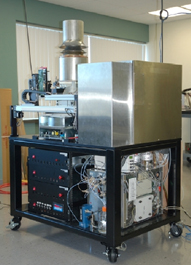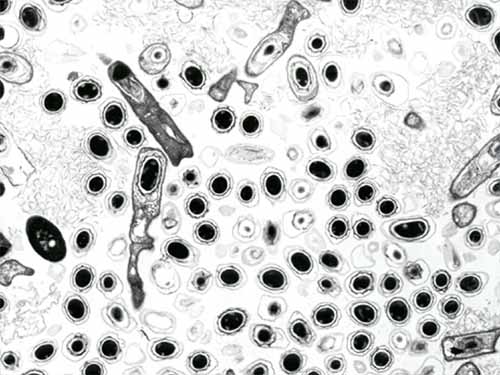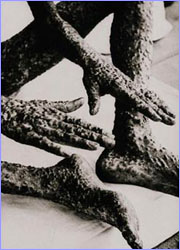
Photo Courtesy of Homeland Security Science and Technology, June 2007
Literature Research was identified as a key step in the Biological Sensor Fusion team processes and technical approach. The literature researched in this project fell mainly into four distinct categories: Current Biological Threats and Defense of Urban Environments, Disease Characteristics, Algorithms and Models, Sensor and Health Characteristics. Each section of research is subdivided below:
Research in this category includes investigating what biological outbreak defenses are in place (e.g. counter proliferation, consequence management, medical countermeasures, biological detection, and bioforensics) against possible terrorist attacks.
Urban environments today lack automated technology that is capable of detecting and identifying biological threats sufficient to guide emergency response. In the absence of a robust automated sensor grid, the focus from the U.S. Department of Defense since 2001 in the bioterrorism sector has been on deterrence, counter proliferation and nonproliferation, i.e. establishing regulations and policies preventing the export and creation of biological weapons in counties worldwide. This is because detection using biological sensors has traditionally been problematic. Quoting from the National Biodefense Strategy, “There is no automated technology available today for homeland security use that is capable of detecting and identifying biological agents with sufficient specificity and sensitivity to guide responses. The best available technology for detection of biological agent aerosols involves the use of dry filter units that collect particles from the air over a period of time, followed by transfer of the filter to a laboratory using protocols established by the Centers for Disease Control and Prevention (CDC) Laboratory Response Network.” Today, the National Biological Weapons Analysis Center has the responsibility to advance areas such as infectious diseases prevention, detection, diagnostics, and forensics.
In the 2001 letter mailing of anthrax to Senator Tom Daschle (D-SD), tens of millions of dollars were spent in cleanup of the mail distribution and congressional office locations, and twenty two people were infected with either cutaneous or pulmonary anthrax, resulting in five deaths. Some facilities were still closed as long as two years following the event. In the Daschle letter, only 2g of dry anthrax were used. Had this been possible to detect, perhaps these lives and potentially millions of dollars could have been saved. However, the U.S. is not spending a lot of funding on sensor based detection. The Department of Homeland Security is focused instead on medical countermeasures, i.e. providing vaccine stores and treatment response plans both nationally and regionally. Medical countermeasures in urban environments today include treatment and vaccine distribution in “12 hour push packs” delivered from the Strategic National Stockpile. Cities would take these stores and provide delivery to city residents via specially trained postal workers on regular routes. While this is ultimately needed in response to a biological outbreak, it relies on hospitals and medical practitioners rapidly reporting infected patients nationally.
 |
| The BioWatch Generation 3 Sensor. Photo Courtesy of Homeland Security Science and Technology, June 2007 |
If an automated sensor-based public health surveillance system were to be designed for early detection of biological attacks, it would involve monitoring and linking these public and private databases on a national scale and providing resources that would allow states and cities to monitor diseases outbreaks in parallel. “Ideally, it would be possible to detect an aerosol release of biological agents by relying on networks of detectors in every urban area. While tests and limited deployments suggest that it should be possible to develop detection architectures that can support public health and medical responses, the United States is only beginning to develop capabilities in this area.” Biowatch, a program created in 2003, is responsible for deploying a national urban sensor network program. Using up to 50 sensors per city, Biowatch is designed to provide coverage for 80 percent of the population in urban environments, including Washington, New York, Chicago, Houston, San Francisco, San Diego and Boston. The intent is to detect a biological agent within 36 hours of release and give authorities time to react properly. However, even this still leaves one and a half days before a full response is made. This is because the sensor's disposable filters are collected once daily and analyzed for threat biological samples at facilities belonging to the Laboratory Response Network under the Department of Health and Human Services. False positives are a significant concern given the potential costs associated with a response to a perceived biological attack.
Of further concern is that the current U.S. medical system is a collection of independent business entities that require patients to pay for health care. They traditionally do not communicate well with one another or have nationally linked data exchange capabilities. “Ideally, the [Biological Sensor Fusion] system would share infectious disease information with all physicians on the system and with higher-level government offices while simultaneously returning guidance to physicians from their local public health agency, as needed.”
Cited References:Biological (bacterial and viral) pathogens were researched, to include problems in collecting/manufacturing, dispersion methods and rates, toxicity/mortality rates, ease of detection/diagnosis, and existing treatment/vaccination drugs and procedures.
The use of Biological weapons can provide three main benefits to terrorists:
The use of Biological weapons like Anthrax and Smallpox can be fatal and can kill thousands of people. The most scary thing about biological weapons is that it is highly cost effective and a small amount of Anthrax bacteria or Smallpox virus can be transported through airports and are undetectable through security check points. These biological weapons can be reproduce also under favorable weather conditions and by trained experts.
 |
| Photo Courtesy of Wired, 10 October 2001 AP Photo |
The inhalation of Anthrax spores can cause fatigue, coughing, fever and chest pains and an infected person can die within 24 to 36 hours. Early detection of Anthrax and taking large amounts of vaccine can help the patient survive. If Anthrax spores remain in the air and humans inhale it, then it can be fatal. However, because Anthrax is hard to aerosolize, spores quickly fall on the ground and can be difficult to disperse as an inhalation threat. Anthrax appears on the ground naturally and humans, if exposed, can be infected cutaneously from remains of dead animals, fur, wool or skin of animals. Anthrax is not contagious but can be transferred from the clothing or shoes from one individual to another. Anthrax spores have a long life-span in a variety of weather and environmental conditions after release. An Anthrax infected area should be cleaned with oxidizing agents like peroxides, ethylene oxide, Sandia Foam, chlorine dioxide and liquid bleach. These agents can be very useful in killing Anthrax spores and filtered the area.
 |
| Photo Courtesy of PBS NOVA Online, Bioterror, November 2001 |
The Smallpox disease is caused by a virus called Variola major virus. The Smallpox virus can be the most deadly Biological weapon that can use by the terrorists. The virus is highly contagious, lethal and can be spread through breathing. The Smallpox virus can cause severe rash, fatigue, headache, backache, high fever and fluid filled blisters. The United States stopped the regular production of Smallpox vaccination in 1972. It has increased the production recently after the terrorist threats.
A small amount of smallpox could be released in a container the size of a light bulb and affect nominally as many as 100 people, who in turn might affect up to 10,000+ more via airborne contagion or contact with other people before the outbreak was even noticed by doctors/hospitals. If not vaccinated, the death toll can easily rise into the millions. In particular, the outbreaks of smallpox in Germany in 1970 and Yugoslavia in 1972 present important case studies.
In Germany, a country with good vaccine stores against smallpox, only one infected person caused more than 100,000 people to be vaccinated, and even then 19 other people still became infected and several died. Yugoslavia on the other hand, did not fare as well. Only one infected individual caused 175 other patients to contract smallpox, and 35 died. This would have been much worse though if the country hadn't closed all its borders, isolated more than 10,000 people in hotels and residential apartments under military guard, and vaccinated twenty million persons inside the country! And this all had to be done in only nine weeks.
Anthrax is not much less lethal. In 1979, in Sverdlovsk Russia, an accidental release of less than a gram of anthrax aerosol for no more than a few minutes caused more than 66 deaths in less than 4 days and infected livestock up to 50km away. Nearly 59,000 people had to be vaccinated with penicillin prophylaxis and anthrax vaccine. This release was caused by an accident at a Russian military bioweapons facility, to which President Boris Yeltsin admitted in 1992. The anthrax leak was caused by workers who forgot to replace a filter in an exhaust system. If the wind had been in the opposite direction that day, toward the city of Sverdlovsk, the death rate could have been in the hundreds of thousands.
Cited References:The Biological Sensor Fusion project researched data algorithms and data types that allow for rapid data collection and data exchange (e.g. epidemic, rumor, gossip, agent based, etc.) as well as geographic selection algorithms for determining best network communication paths (e.g. routing, geocasting, rendezvous, etc.). Communication algorithms will be evaluated for their ability to rapidly transmit data, and data parameters will be defined for data to be passed (latency, membership, buffering, how often, who do you talk to, etc.). For models, the team investigated existing heterogeneous ad-hoc fusion models and determine if any of these can be used in the development of the end-to-end system expected as a result of this project.
Notional Sensor and Communications Modeling Approach Presentation, 3 March 2008.
Cited References:Existing biological agent sensors have limitations on what can and can not be detected based on their pre-existing parameters. Further, many require processing time and validation by microbiology laboratories. Current sensors were researched along with their benefits and limitations. Also, medical practitioner data due to the appearance of infected individuals at health care facilities are also included: What types of data is collected, how timely is it, and how is it disseminated.
Several existing companies recognize the importance of biological threat detection sensors. The U.S. Department of Homeland Security Advanced Research Projects Agency (HSARPA) issued two new research project areas in September 2003 for vendors to develop sensors, amounting to $48 million over 18 month periods of performance. These include:
Note that the Biological Sensor Fusion system would fall in both categories.
Additionally, the Defense Advanced Research Projects Agency (DARPA) has similar goals, planning between $110 and $155 million annually to develop bioweapons sensors that have greatly improved sensitivity and response time to sensors available today. These include:
A number of companies are actively researching this topic area, validating the need for a Biological Sensor Fusion model:
 |
| Chicago Illinois Photo Courtesy of Destination 360, 2008 |
In addition to companies working on Biological Sensor Fusion solutions, the BSF team also investigated a specific use case for demonstration of our model. We chose Chicago as the urban city of choice to protect against a biological terror threat. Information collected to date on the City of Chicago includes: